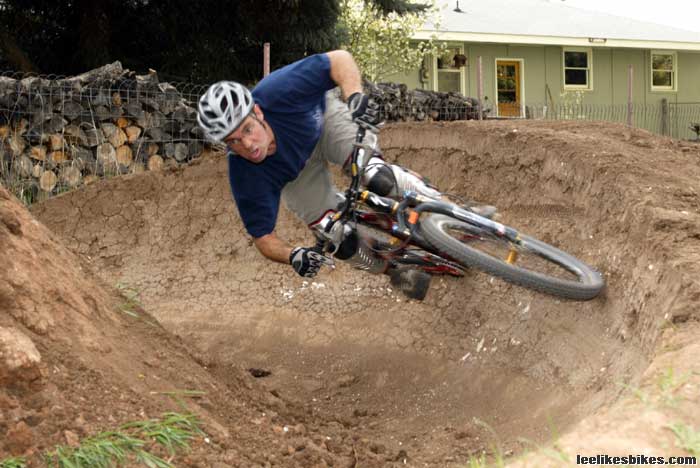7th grade math report: Pulling Gs on a pump track

Lee,
I’m doing a math report on mounain biking and I am in 7th grade. I met with Mark Weir and he said you hade done some studies on the G forces pulled on his pump track. Is there any way I could get a hold of the results to present to my class?
Travis
 Jiro Nakamura, an ex World Cup DH pro, pulls a couple Gs on Weir’s track. |
Hey Travis,
As you might know, cornering Gs are a function of your speed and the radius of the turn.
The equation is (velocity squared/radius)/9.81 — You must use metric units!
The tighter the turn, the greater the Gs. That’s a linear relationship. Twice as tight, twice as many Gs.
The faster you go, the greater the Gs. This is exponential. Twice as fast, four times the Gs.
When you turn, your lean angle balances out the forces of gravity and turning. If you are pulling one G, you must lean 45 degrees. Make sense?
When you look at a rider ripping a turn on the track, you can tell his cornering Gs by the amount of his lean. By lean I mean the angle between the contact patch of his tire and the center of his mass (basically his belly button).
– 45 degree lean = 1 G
– 63 degree lean = 2 Gs
– 72 degree lean = 3 Gs
I’ve seen Weir and other top riders pull up to 3Gs in a pump track berm. That’s like the most intense roller coaster — in your own backyard!
You can find Excel calculators on this page. “Bike cornering” has all the math you need to calculate cornering Gs and lean angles.
https://www.leelikesbikes.com/calculators.html
I hope this helps. Good luck on your report!
— Lee
 The Mighty Weir Himself. Look at how much speed he’s carrying out of the corner. Heck, he’s still leaning; the landing of the double is a continuation of his turn. Sick! |
Know more. Have more fun!
Join the leelikesbikes mailing list:

Comments are closed.